How to remove blank spaces on all four sides of the screen of Samsung S24AM50?
- PPerry RuizSep 14, 2025
Adjust the screen size in the HDMI or DVI settings for the graphics card.
How to remove blank spaces on all four sides of the screen of Samsung S24AM50?
Adjust the screen size in the HDMI or DVI settings for the graphics card.
Why there is no sound from my Samsung S24AM50 Monitor even at maximum volume?
Check the volume control of your product, and then check the volume control of the external device.
Why no sound is heard on my Samsung Monitor?
Check whether Digital Output Audio Format is set to Pass-Through.
Why is there no sound on my Samsung S24AM50 even though the picture is good?
Set Sound Output to Device Speaker.
Why can't I adjust the volume of the external device on my Samsung S24AM50?
Check the cable connection between the product and the external device.
Why Anynet+ does not work on my Samsung S24AM50?
Confirm that the device is an Anynet+ device.
Why is the screen unstable and shaky with shadows on my Samsung Monitor?
Check that the resolution and frequency for the PC are within the range of resolution and frequency compatible with the product.
Why are the speakers making an odd sound on my Samsung S24AM50?
Run Sound Test.
Why does the message "Connecting to Anynet+ device..." appear on the screen of Samsung S24AM50 Monitor?
You cannot use the remote control when the product is configuring Anynet+.
How to fix blurry text on Samsung S24AM50 Monitor?
Go to Control Panel ? Fonts ? Adjust ClearType text and change Turn on ClearType.
Guidelines for safe electrical usage and handling of power cords.
Critical warnings about installation near heat sources and packaging hazards.
Warnings and cautions about product handling, moving, and assembly.
Step-by-step instructions and precautions for cleaning the product.
Detailed steps for assembling the monitor stand for specific models.
Steps for securing the product using an anti-theft lock.
Explanation of the on-screen control menu and power indicators.
Identification and description of connection ports on the product.
Overview of connecting various external devices like audio, video, and PCs.
Steps to check network status and configure wireless connection.
Method for sharing mobile screen content by tapping the device.
How to select and customize connected external devices.
Recommendations and precautions for using HDMI cables and connections.
Precautions for USB Type-C and mobile device connections.
Introduction to the Samsung Smart Remote and its pairing process.
Explains buttons like Power, Voice Assistant, and Picture Mode.
How to connect and control external devices via HDMI-CEC.
Instructions for connecting USB and Bluetooth input devices.
How to use the virtual keyboard for text input on the product.
Overview of Smart Hub's capabilities for apps, internet, and media.
Navigating the Home Screen and accessing quick settings.
Finding content and managing installed applications.
Guide to creating and signing into a Samsung account.
Accessing your PC or work resources remotely.
Wireless sharing, DeX, Office 365, and cloud service access.
Overview of downloading, searching, and managing applications.
Uninstalling apps and adding favorites to the Home Screen.
Accessing and playing media content from storage devices.
Playing media from PC, mobile, USB, and streaming mobile audio.
Overview of voice control with Bixby.
Navigating Bixby interface, tutorials, and settings.
Options for customizing picture settings and modes.
Detailed adjustments for Brightness, Contrast, Color, and more.
Selecting sound modes and digital audio output formats.
Choosing audio output speakers and connecting Bluetooth audio devices.
Setting the current time and adjusting the clock for DST and time zone.
Activating screensavers and reducing power consumption via brightness.
Methods for updating product software.
Overview and activation of voice guides and accessibility shortcuts.
Adjusting voice guide, screen contrast, and font size.
Enabling, splitting, selecting language, and customizing digital captions.
Selecting between Bixby or Google Assistant.
Managing devices, using AirPlay, and restoring factory settings.
Important information and limitations before using apps.
Notes and restrictions for using the internet browser.
Precautions and security protocols for wireless internet setup.
Supported file types and media playback limitations.
Lists of supported subtitle formats and video formats with subtitles.
Supported image, resolution, music file types, and codecs.
Details on video codecs, containers, and audio codecs.
Mapping input signals to picture sizes and modes.
Instructions for anti-theft lock and UHD signal resolution support.
Guidelines for connecting PCs and VESA DMT standard resolutions.
Guidelines for connecting PCs and VESA CVT standard resolutions.
Table of CTA-861 standard resolutions and timings.
Recommended graphics cards for HDR10 support.
Precautions and limitations when using Bluetooth devices.
Information about Easy Setting Box and installing product drivers.
Steps to resolve common picture problems using Picture Test.
Adjusting brightness, resolving blur, and troubleshooting power off issues.
Resolving color issues, captions, and HDR problems.
Resolving power issues, distorted images, and blurry text.
Using Sound Test and checking audio connections for sound issues.
Resolving sound interruptions and external volume control issues.
Resolving "Mode Not Supported", no audio, and no screen issues.
Resolving PC screen flickering, no display, and input errors.
Resolving wireless, wired, IP configuration, and internet connection failures.
Resolving issues with Anynet+ (HDMI-CEC) functionality.
Steps to resolve remote control and external device operation issues.
Resolving common app issues and media file playback errors.
Resolving voice command and recognition issues with assistants.
Resolving issues like product heat, plastic smell, stand wobble, and settings reset.
Using diagnostic tools and resetting Smart Hub, picture, and sound settings.
Accessing remote support and finding service contact details.
Technical specifications for different monitor models.
Conditions for service charges and product damage due to customer fault.
| Aspect Ratio | 16:9 |
|---|---|
| Viewing Angle | 178°(H)/178°(V) |
| Resolution | 1920 x 1080 (FHD) |
| Brightness | 250 cd/m² |
| Connectivity | HDMI |
| Speakers | No |
| VESA Mount | 100 x 100 mm |
| Color Support | 16.7 million |
| Screen Size | 24 inches |
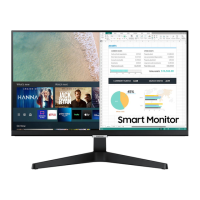
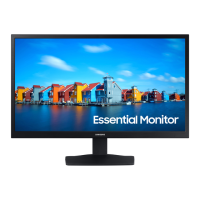
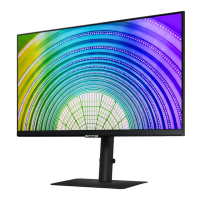

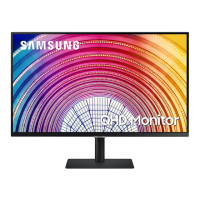
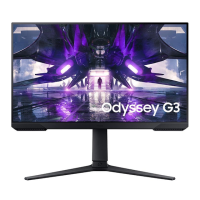
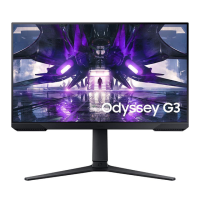
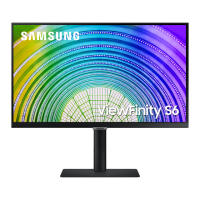
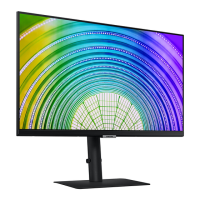


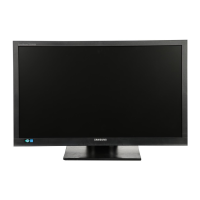
